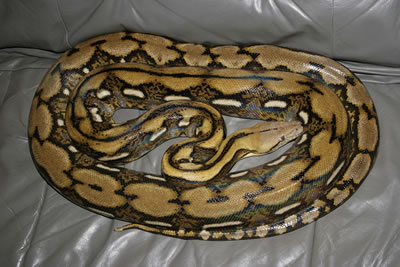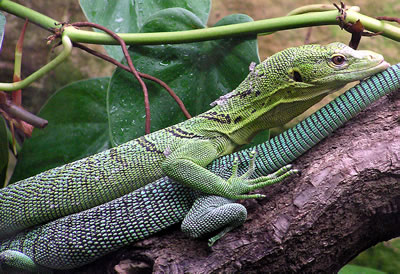Snakes and Lizards

Facts about creatures
- Home
- Animal Classification
- Animal Habitats
- Amphibians
- Arthropods
- Bats
- Birds
- Carnivorans
- Cetaceans
- Chordates
- Crustaceans
- Dinosaurs
- Diprotodonts
- Elephants
- Fish
- Golden Mole
- Insects
- Lagomorphs
- Mammals
- Mammal Teeth
- Marsupial Mole
- Metamorphosis
- Mollusks
- Primates
- Reptiles
- Rodents
- Ruminants
- Soricomorphans
- Tenrec
- Tetrapods
- Vertebrates
Snakes and Lizards
Squamates (Squamata) is the order of reptiles that includes the snakes and lizards.
There are more than 7,000 species of snakes and lizards on Earth.
Snakes and lizards live all over the world, in many different habitats
They make up the largest order of reptiles. It is estimated that about 95% of reptiles are squamates.
The longest squamate on Earth today is the reticulated python (Python reticulatus), a snake that can grow up to 28 feet long.

The heaviest squamate that is alive today is also a snake – the green anaconda (Eunectes murinus), which can weigh up to 500 pounds.
There are rumors of reticulated pythons that are even longer and of green anacondas that are even heavier.
The smallest living squamates are two species of gecko (a type of lizard): the Virgin Islands Dwarf Sphaero (Sphaerodactylus parthenopion) and the Jaragua Sphaero (Sphaerodactylus ariasae), both of which can be found in the Caribbean. They are about three fifths of an inch long, not including their tails.
These two geckos are the smallest of all living reptiles.
Physical characteristics
The skin of a snake or a lizard is covered with horny, overlapping scales. Squamata is Latin for “scaly”.
Snakes and lizards can open their jaws very wide.
This is because they have quadrate bones that can move separately from their skulls.
The quadrate bone forms part of the jaw joint in reptiles, amphibians and birds.
In mammals, the quadrate bone has evolved into part of the middle ear.

In addition to using their noses and tongues to sense chemicals – their noses for smelling and their tongues for tasting – most squamates can detect chemicals using a sensory organ that is known as Jacobson’s organ, which is located at the roof of the mouth.
A lizard or snake will detect chemicals in the air by flicking out its tongue and then placing its tongue on its Jacobson’s organ.
Reproduction
A male squamate has a pair of copulatory organs, which are known as hemipenes. (The singular term is hemipenis.)
The male only uses one hemipenis at a time.
Squamates may be oviparous (lay eggs) or viviparous (bear live young). Some squamates are ovoviviparous – the female lays eggs and then keeps them in her body until they hatch.
A few species of squamate are parthenogenetic. This means that the female can produce offspring without having a male fertilize her eggs.
Difference Between Snakes and Lizards
Snakes differ from lizards in that lizards have eyelids, while snakes do not. A snake has a clear scale, known as a spectacle, over each of its eyes. This means that it looks like it always as its eyes open.
In addition, lizards have external ear holes, while snakes do not.
Scientists think that snakes may only be able to hear very low frequency vibrations.
Snakes have much more flexible jaws than lizards.
Because the jaws of snakes are so flexible, snakes can open their mouths much wider than lizards can.
A snake can open its mouth so wide that it can swallow prey that is much larger than itself in one gulp.
In snakes, the paired organs, such as the adrenal glands and kidneys, are placed one in front of the other instead of side by side. This allows a snake to have a very narrow body.
A lizard has two lungs, but a snake has only one working lung (the right lung). It may have no left lung at all, or it may have an atrophied left lung that no longer functions – a vestigial left lung.
A vestigial organ is an organ that an animal inherits from an ancestor during the process of evolution, but no longer uses.
Vestigial organs are often atrophied.
The most obvious difference between lizards and snakes may seem to be that lizards have legs while snakes do not.
However, while some snakes have no legs, some lizards also have no legs.
These legless lizards retain remnants of pelvic girdles (hip bones) and pectoral girdles (shoulder blades and collar bone).
Most snakes have completely lost their pelvic girdles and pectoral girdles.
Snakes in the family Boidae, which includes boas and pythons, have retained part of their pelvic girdles and have small, vestigial hind legs on each side of their cloacas.
These vestigial legs cannot be used for locomotion. They look like small claws and are known as anal spurs or pelvic spurs. Males use their anal spurs to clasp females during mating.
Snakes and legless lizards move in different ways.
A snake uses the muscles in its sides and the muscles and the scales on its belly to push itself forward.
The scales on a snake’s belly come in different shapes and are specialized for moving along surfaces.
A snake will use the scales on its belly to create friction along the surface. That friction helps to push the snake forward.
A legless lizard can only use the muscles in its side to move. It moves forward by bending itself sideways and pushing against objects. If a legless lizard is on a completely flat surface, it cannot move.
Classification
Squamates belong to the group of amniotes that are known as diapsids.
Every diapsid has two temporal fenestrae on each side of its skull, or is a descendant of an animal that had two temporal fenestrae.
Temporal fenestrae (singular is temporal fenestra) are holes in the side of an amniote’s skull, either above or behind the eyes.
Squamates, tuataras, alligators, crocodiles and birds are diapsids.
Dinosaurs were diapsids.
Within the diapsids, squamates and the tuatara comprise the Lepidosauria – reptiles with scales that overlap.
According to cladistics, squamates form a clade.
A clade is a group of animals that descended from a common ancestor. All of the descendants of that common ancestor belong to that clade.
All squamates descended from a common ancestor.
Within the squamates, snakes make up their own clade, which is known as Serpentes.
All of the other squamates are collectively known as lizards.
Lizards, themselves, do not make up a clade. They are a paraphyletic group.
A paraphyletic group is one in which every member of the group shares a common ancestor, but that common ancestor also has descendants that aren’t included in the group.
All lizards descend from a common ancestor. However, snakes also descended from that ancestor, but aren’t included in the group “lizards”.
There are many different clades of squamates whose members are called lizards.
Each of these clades is just as closely related to snakes as they are to the other clades of lizards.
Some people use the word “lizard” to mean any squamate. Therefore, they would say that a snake is a kind of lizard.